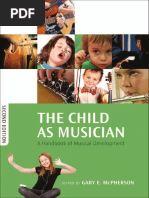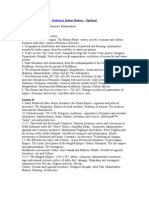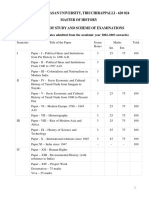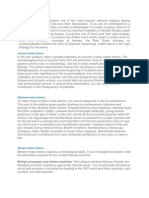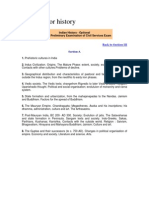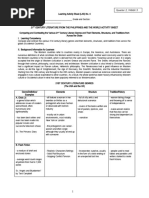History (Code No. 027) : Rationale
History (Code No. 027) : Rationale
Uploaded by
Shobhit MishraCopyright:
Available Formats
History (Code No. 027) : Rationale
History (Code No. 027) : Rationale
Uploaded by
Shobhit MishraOriginal Title
Copyright
Available Formats
Share this document
Did you find this document useful?
Is this content inappropriate?
Copyright:
Available Formats
History (Code No. 027) : Rationale
History (Code No. 027) : Rationale
Uploaded by
Shobhit MishraCopyright:
Available Formats
21. History (Code No.
027)
Rationale After ten years of general education the two years of senior secondary stage aims at initiating the pupil into the study of courses in a few subjects of his/her choice. This stage is very significant both as a terminal stage of school education enabling the pupil to enter life and as a preparatory stage equipping him/her to pursue higher academic studies in a few selected subjects. For the first ten years of schooling, history forms an integral part of the social science curriculum in general education. It aims at introducing the pupil to some of the main trends and developments in the history of India and of the world. History as an independent discipline is being introduced at the senior secondary stage. The pupil may be initiated into a systematic study of the subject for the first time and introduced to the rigours of the discipline. While developing these courses, care has been taken to devise them in conformity with the approaches and findings of modern historical scholarship. Details of dynastic and administrative history and biographical details have been reduced to the minimum and necessary emphasis has been given to the study of social and economic forces, political institutions and cultural and scientific developments. While devising courses in Indian history, an attempt has been made to enable the pupil to develop an understanding of developments in all parts of the country and not only of those areas which were important as centres of large kingdoms and empires. The course on history of the contemporary world aims at promoting an understanding of the contemporary world in a historical perspective. Objectives The objectives of the history courses at this stage may be as follows:
to initiate the pupil into methods of historical enquiry; to provide authentic historical knowledge and understanding of those regions and periods which the pupil has chosen to study; to develop an attitude of studying the past in its context; to help develop a spirit of enquiry and critical appreciation of the past so that pupil's personality is free from prejudices and bigotry, parochialism and communalism; to help develop an understanding of the importance of historical perspective in the study of contemporary issues and problems.
CLASS XI Paper One Time : 3 hours 100 Marks
Unit PART A - ANCIENT INDIA
Periods
Marks
1. 2. 3. 4. 5. 6. 7. 8. 9. 10. 11. 12. 13. 14. 15.
Introduction Paleolithic Cultures and Beginning of settled Life The Harappan Civilization The Early Vedic Period
8 4 8 8 7
Later Vedic Phase and Iron Age South and North-East India 5 South and North-East India Religious traditions Mahajanapada Mauryas Society ,Economy and Culture during Mauryan period Post-Mauryan India The age of India from Guptas and after The Society and Culture in the age of Guptas and Harsha Society ,Economy and Culture life in Ancent India Map and Work 2 10 4 10 5 6 8 8 10 8 8 7 5 9 7 5 2
PART B - MEDIEVAL INDIA
16. 17. 18. 19. 20. 21. 22.
Rise of Islam In arabia North India between 800 AD - 1000 AD South India between 900 AD - 1200 AD Advent of turks Founding of Delhi Sultanate Rise of Vijayanagar and Bahmani Kingdoms Distintegration of Delhi Sultanate and emergence of independent States Socio-economic and religious development during the Sultanate Founding of the Mughal Empire Expansion and consolidation of Mughal Empire Struggle for succession Rise of Maratha Power Social - Cultural and religious developments under the Mughals Map and Work Project Work
4 8 6 2 18 4
23.
6 8 8 9 9
24. 25. 26. 27. 28.
6 5
4 5 5
29. 30.
Class XI : Ancient India 1. Introduction :- Traditions of History Writing Beginning of Modern Historiography Sources of Ancient India: Literary Archaeological Foreign Accounts Geographical Background of Indian History. 2. Paleolithic Cultures and Beginning of Settled Life : - Paleolithic period Mesolithic Neolithic Age Beginning of the settled life Agriculture and Domestication of animals, Chalcolithic cultures. 3. The Harappan Civilization :- Phase,Extent and Antiquity Town Planning Buildings, Drainage,GreatBath,Granaries,Fortification, etc. - Economic Activities : Weights and measures, Tools and Implements, trade, commerce and industries. Religious Life Funerary Customs Art and Aesthetics Dress Ornaments. Harappan Script Contacts with other Contemporary Civilizations. 4. The Early Vedic Period : - RigVedic India Geographical Extent Religious Traditions, Political Organization Sabha, Samiti, Rashtra, etc. Society and Economy. 5. Later Vedic Civilization and Iron Age :- Geographical Extent Society and Economy Settlements in Ganga Plains Iron Phase. 6. South and North East India :- South India from Megalithic Culture to Sangam Age The Archaeological Cultures of Eastern India. 7. Religious Traditions :- The Rise and Growth of Jainism Doctrines and the philosophy Spread of Jainism Contribution of Jainism Gautam Buddha Early Life Dhamma The doctrines of Buddhism Sangha Spread of Buddhism Vaishnavism and Shaivism Six Schools of Philosophy. :The Sixteen 8. Mahajanapadas Mahajanapadas The Republics Rise and Expansion of Magadhan Empire Iranian and Macedonian Invasion and their Impact. 9. Mauryas :- Rise of Chandragupta Maurya Ashoka and his conquests Extent of Mauryan Empire - Arthashasthra Mauryan Administration. 10. Society,Economy and Culture During and After Mauryan period :- Society Economy Religion Art and Achitecture Language Science and Technology Artisans and their Organisation Trade and Commerce Ashokan Inscriptions Ashoka and spread of Buddhism The Decline Of Mauryas. 11. Post Mauryan Period :- The political situation in Post-Mauryan Period : the Shungas and Satavahanas-Chedis-CholasPandyas Cheras Pallavas Kanvas - The Indo Greeks - Sakas and the Parthians-The Kushanas. The Rise of Powers in North and East-Satraps of Western India.
12. The Age of Guptas and After :- The emergence of the Guptas - Chandragupta I, Samudragupta and Chandragupta II. Expansion and Consolidation of Gupta Empire - Gupta Polity - Administration - The Later Guptas and the Decline of the Dynasty Hunas - India after the Decline of GuptasRise of Vallabhis - Gauda-Pallavas, Gangas, Chalukyas, Kadambas, Rashtrakutas North India after the Guptas Harshas kingdom. Other Dynasties of Deccan and the South.
Technology-Social Conditions - EducationEconomic conditions - Trade and Commerce-India and the Outside World - Cultural Interaction with Outside World with Special Reference to South East Asia. 14. Social,Cultural, Economic life of Ancient India :- Language and Literature-Religion and Philosophy-Social and Economic life-Art and Architecture-Science and Technology-Trade and Commerce Crafts-Spread of Indian Culture Abroad with Special Reference to East Asia
13. Society and Culture in the age of Guptas and Harsha : Literature Sanskrit Tamil 15. Map Work - Foreign accounts Buddhism - JainismVaishnavism - Shaivism - Minor Religious Sects-Art and Architecture-Science and
Class XI : Medieval India
16. Rise of Islam in Arabia :- Arab expansion in 19. Advent of the Turks :- The Gazhnavids East and South East Asia Arab invasions. Mahmud Gazhnavi Impact of his Invasions The Rajput States Conquests of Lahore, 17. North India between 800 AD - 1000 AD :Thaneshwar, Mathura, Kannauj and Somnath Emergence of Gurjara-Pratiharas Conflicts Muhammad Ghauri. Political Condition of India between Pratiharas, Palas and Rashtrakutas. in Twelfth Century A.D. The struggle for domination. Other Dynasties of Northern India - Chandelas, Parmaras, 20. Founding of Delhi Sultanate and Expansion : - Mameluks Alauddin Khalji Tughlaks Chauhans and Kalchuris, Gahadvalas. Expansion of Empire Administration and 18. South India between 900 AD - 1200 AD :Economic reforms. The Chola empire-Rise of Chola Empire Their conquests, administration, cultural activities
21. Rise of VijayNagar and Bahmani Kingdoms 25. Expansion and consolidation of Mughal Empire :- Akbar, Jehangir and Shahjahan:-The Vijayanagar Empire- Conflict with Expansion and consolidation of Mughal Bahmani kingdom. Religious and Cultural life Empire. Religious reforms and Rajput policyof Vijayanagar Reorganization of Administration and Army. 22. Disintegration of Delhi Sultanate and Emergence of Regional States :- Sindh, 26. Struggle for Succession : - AurangzebGujarat, Malwa, Bahmani and its Five Religious and Administrative Policies-Sikhs Successor States. Sayyids, Lodhis and Founding of Khalsa, Bundelas, Jats, Satnamis Afghans. and Rajputs. Disintegration of Mughal Empire. 23. Economic, Social, Religious and 27. Rise of Maratha Power :- Shivaji and Aurangzeb-Bijapur, Golconda, Ahmadnagar administrative changes during the Sultanate and Bidar-Mughal-Maratha struggle - Shivaji's :- Bhakti and Sufi Movements Language and Administration and Achievements. Literature. 24. Founding of Mughal Empire :- Babur's 28. Economic, Social, Cultural, Religious invasion-First battle of Panipat 1526-Battle of developments under the Mughals. Khanwa-Afghans at Delhi-Humayun-Shershah struggle. 29. Map Work 30. Project Work
CLASS XII Paper One Time : 3 hours 100 Marks
Unit PART A - MODERN INDIA
Periods
Marks
1. 2. 3. 4. 5. 6. 7. 8. 9. 10. 11.
India in the Late Eighteenth Century Coming of the Europeans and the Rise of the British India Under East India Company ( 1957-1857) Uprising of 1857 Changing after 1857
10 10 06 04 10 10 10
Social Cultural and Regligious Awaking in the 19th Century 10 Indian National Congress (1885-1905) Growth of Nationalism (1905-1918) Rise of Gandhi in India Political scene (1915-20) Struggle for Swaraj and making of Indian Constitution Map Work Part B CONTEMPORARY WORLD 08 06 10 12 06 10 13 12 05
12. 13.
Introduction The world from the end of the 19th Century to the end of the First World War The World from 1919 to 1939 The Second World War The World after Second World War
04
14 16 10 12
05 07
14. 15. 16.
10
17. 18. 19.
Development in Asia and Africa Khurschev Era in U.S.S.R Development in Science and Technology or development in Art , Literature, Media and Cultura Map Work
10 10 07
12 06 05
20.
Class XII : Modern India 1. India in the Late Eighteenth Century :- 7. Indian National Congress (1885-1905) :- Its Character, Demands and Methods of struggle. Disintegration of Mughal Empire and Rise of 8. Growth of Nationalism (1905-18) :- Partition Marathas - Emergence of Regional Subahsof Bengal and Swadeshi Movement Militant Awadh, Bengal, Hyderabad, Mysore, Kerala Nationalism ideas and practices. Congress Rajputs . Social, economic and cultural life. Split at Surat (1907) Repression of Nationalists and revolutionaries Formation of 2. Coming of the Europeans and the rise of the Muslim League Government of India Act. British :- European Settlements in India 1909 Annulment of Bengal Partition (1911) Anglo French Rivalry in South India Outbreak of the First World War - Annie British Successes in Bengal (Plassey 1757) Besants Home Rule Movement Lucknow Buxar (1764) Dual Administration in Bengal. Paet between Congress and Muslim league (1916) Ghadr Party Harding Bomb Case. 3. India under East India Company (1757 9. Rise of Gandhi in Indian Political Scene 1857 ) :- Administrative, Judicial, Revenue (1915-1920) :- Return from South Africa with Organization Education and Language New Ideology-Ahimsa and Satyagraha-Hind Religious and Social Policy Economic Policy Swaraj (1909)-Constructive ProgrammeAgriculture and crafts. Swadeshi and Swaraj-Opposition to Council Entry. 4. Uprising of 1857 : - Cause of the Revolt - its spread - nature and repression. 5. Administrative changes after 1857 :Economic Impact of the British Rule - condition of the artisans, peasantry, landlords problems of agriculture and industries. 6. Social, Cultural and Religious Awakening in the 19th Century :- Rammohun Roy, Ishwar Chandra Vidyasagar Brahmo Samaj Ramkrishna Vivekanand Swami Dayanand and Arya Samaj Jotiba Phule Veerasilingam The Aligarh School. 10. Struggle For Swaraj and Making of Indian Constitution : - Montagu Chelmsford Reforms Rowlatt Act JallianwalaBagh Massacre Simon Commission Nehru report Gandhiji's Satyagrahas-Local ExperimentsChamparan, Kheda and AhmedabadJallianwala Bagh Massacre-Non-cooperation (1920)Khilafat and Swaraj-Civil Disobedience (1930)Government of India Act 1935, Individual Satyagraha (1940) Quit India Movement (1942) INA Constitutional development after the Second World War Communalism and partition of India the achievement of Independence Immediate problems of the Independent nation. 11. Map Work
Class XII : The Contemporary World 12. Introduction :- Contemporary period in world history - Distinction between contemporary history and modern history-Characteristic features of contemporary history - A survey of the historical background of the contemporary world. 13. The World from the end of the nineteenth Century to the end of the First World War : - Developments leading to the First World War Consequences of the War and its impact on India - The Russian Revolution. 14. The World from 1919 to 1939 :- League of Nations-Fascism in Italy-Economic depression-Its economic, social and political consequences-Nazism in Germany-The New Deal-Growing importance of the U.S.A.developments in Britain and FranceEmergence of the U.S.S.R.-Developments in Africa and Latin America-Nationalist movements in Asia-Militarism in Japan and its emergence as a world power. Aggression and Appeasements-Japanese invasion of ChinaItalian invasion of Ethiopia-Germany's role in world affairs- Civil War in Spain. 15. The Second World War : - Causes of the Second World War-German, invasion of Poland and outbreak of war-Fall of FranceInvasion of the USSR-US in the War. The Atom Bomb-End of the War-Destruction caused by the War-Plans of the post-War reconstruction-United Nations-UN Declaration of Human Rights.
16. The World After The Second World War :- General Features-Political composition of the world after the Second World WarDisintegration of the colonial systemNeocolonialism-Emergence of the U.S.A. and U.S.S.R. as world powers-Formation of IsraelFormation of N.A.T.O. and Warsaw pact-Cold War-Socio-economic impact of cold war in Europe- Formation of N.A.M. 17. De velopme nt in Asia And Af ric a : Revolution in China-Tibet and Indo-China relations-Success of the movements of national independence - Vietnam National Liberation movements in Africa Struggle against apartheid Bandung conference 18. Khurschev Era in U.S.S.R :- Soviet Foreign Policy Turmoil in Eastern Europe Poland, Czechoslovakia and Romania Mikhail Gorbachev Disintegration of Soviet Union Decline of Communism and its impact 19. Development in Science and technology :New sources of energy-Industrial productionTransport and communications- Developments in biological sciencesInformation technology. 20. Development in Art , Literature, Media and Culture :Literature and art in the contemporary world. Impact of the revolution in communications-The mass mediaNewspapers, Radio, Cinema, Television and Computers 21. Map Work
List of Books Recommended Class XI S.No. 1. 2. Name of The Book Name of the Publisher
Ancient India (History) By Prof R.S.Sharma NCERT Publication Medieval India (History) By Prof. Satish Chandra NCERT Publication
Class XII S.No. 3. 4. Name of The Book Modern India (History) By Prof Bipin Chandra Contemporary World (History) Part I & II By Arjun Dev and Others Name of the Publisher NCERT Publication NCERT Publication
You might also like
- The Child As Musician A Handbook of Musical DevelopmentDocument697 pagesThe Child As Musician A Handbook of Musical DevelopmentJesus Yusuf Isa Cuevas91% (11)
- Teach English Now! Capstone Project 2. Fernando FonsecaDocument27 pagesTeach English Now! Capstone Project 2. Fernando Fonsecaferfonsegon100% (4)
- Medieval India Notes PDFDocument197 pagesMedieval India Notes PDFVrushabh Magdum0% (1)
- Voyage A2 Wordlist Unit 1Document2 pagesVoyage A2 Wordlist Unit 1pjmsann1No ratings yet
- B.A History RegularDocument22 pagesB.A History RegularRama Krishna B33% (3)
- History Foundation NewDocument8 pagesHistory Foundation Newsauravsinghss946No ratings yet
- BA History Syllabus 01122015Document16 pagesBA History Syllabus 01122015saranyaNo ratings yet
- Indian History - Optional: (Syllabus)Document6 pagesIndian History - Optional: (Syllabus)Manivannan VenkatasubbuNo ratings yet
- History Optional (UPSC Syllabus)Document9 pagesHistory Optional (UPSC Syllabus)anjuanju1248No ratings yet
- Bharathidasan University Tiruchirappalli 620 0Document21 pagesBharathidasan University Tiruchirappalli 620 0asdfghjklçNo ratings yet
- Rajasthan Public Service Commission, AjmerDocument3 pagesRajasthan Public Service Commission, AjmervivekNo ratings yet
- UPSC History SyllabusDocument6 pagesUPSC History SyllabusShreeya YumnamNo ratings yet
- History Optional SyllabusDocument8 pagesHistory Optional SyllabusAnurag KshatriNo ratings yet
- B - A - History Heritage Management 1Document14 pagesB - A - History Heritage Management 1nivedidha arulselvamNo ratings yet
- NEP UG Course of HistoryDocument4 pagesNEP UG Course of HistoryShinjeeni BasakNo ratings yet
- MDC 1 3 Indian HistoryDocument3 pagesMDC 1 3 Indian Historyshibabhati301No ratings yet
- History Optional Paper - I: 1. SourcesDocument8 pagesHistory Optional Paper - I: 1. Sourcesjason duriloNo ratings yet
- 5 Year Integrated SyllabusDocument34 pages5 Year Integrated SyllabusmaribardNo ratings yet
- BA History Full SyllabusDocument23 pagesBA History Full SyllabusgowthamNo ratings yet
- Civil Service Mains History SyllabusDocument6 pagesCivil Service Mains History SyllabusRELANGIRAMANANo ratings yet
- World History SyllabusDocument6 pagesWorld History SyllabusSujit KumarNo ratings yet
- B.A. HistoryDocument17 pagesB.A. HistoryAnand BalajiNo ratings yet
- UPSC - Mains SyllabusDocument9 pagesUPSC - Mains SyllabuspratyoNo ratings yet
- History SyllabusDocument2 pagesHistory Syllabusytgamer7051No ratings yet
- Vibrant HistoryDocument3 pagesVibrant Historytestmail19253No ratings yet
- Ancient Indian History: British Conquests and Indian Reactions:& $Document5 pagesAncient Indian History: British Conquests and Indian Reactions:& $PrashantSinghPurohitNo ratings yet
- History Honours SyllabusDocument15 pagesHistory Honours SyllabusGulrez MNo ratings yet
- As Proff SyllabusDocument10 pagesAs Proff SyllabusMukeshChhawariNo ratings yet
- IndiaDocument68 pagesIndiaultraaaravNo ratings yet
- History PreliminaryDocument3 pagesHistory Preliminaryv.vigneshNo ratings yet
- History Minar NEP 24Document3 pagesHistory Minar NEP 24Makarand MajhiNo ratings yet
- B.A History.Document14 pagesB.A History.Bangaru Babu0% (2)
- Ug 2nd Semester SyllabusDocument4 pagesUg 2nd Semester Syllabusanirudra6aniNo ratings yet
- eBOOK-24021312304153Document78 pageseBOOK-24021312304153ChetanNo ratings yet
- Mahajanapadas: Ajanta Caves Aurangabad MaharashtraDocument4 pagesMahajanapadas: Ajanta Caves Aurangabad MaharashtraHarshit ShuklaNo ratings yet
- Saarthi History OptionalDocument138 pagesSaarthi History Optionalaamir.hussain82No ratings yet
- FINAL-UG Syllabus Under NEP 2022-18!04!2022Document5 pagesFINAL-UG Syllabus Under NEP 2022-18!04!2022tnegi8126No ratings yet
- Mains PlanDocument21 pagesMains PlanKulhad ChaiNo ratings yet
- History UgDocument12 pagesHistory UgTiger lion LionNo ratings yet
- His Optional Syllabus (WBCS)Document5 pagesHis Optional Syllabus (WBCS)RakeshNo ratings yet
- History TopicsDocument4 pagesHistory Topicsamruthaharidas38No ratings yet
- Indian HistoryDocument3 pagesIndian Historyshubhamsilawat100% (3)
- Examination Booklet December 2023Document15 pagesExamination Booklet December 2023sobhanap02No ratings yet
- Quiz Time History: Improving knowledge of History while being entertainedFrom EverandQuiz Time History: Improving knowledge of History while being entertainedRating: 5 out of 5 stars5/5 (1)
- History Test Series 2022 b2Document10 pagesHistory Test Series 2022 b2Kashiram RaoNo ratings yet
- Syllabus Archaeological Officer PDFDocument14 pagesSyllabus Archaeological Officer PDFAadhith BalasubramaniamNo ratings yet
- UPSC History Optional SyllabusDocument7 pagesUPSC History Optional SyllabusarjunNo ratings yet
- Public Administration: Topic: IAS Prelims Syllabus 2013Document6 pagesPublic Administration: Topic: IAS Prelims Syllabus 2013matrixxxx420No ratings yet
- History of India in Brief For UPSC ExamDocument9 pagesHistory of India in Brief For UPSC Exampriya07rajNo ratings yet
- History Optional SyllabusDocument7 pagesHistory Optional SyllabusShoukath ShaikNo ratings yet
- Indian HistoryDocument5 pagesIndian HistoryRaaj DeshmukhNo ratings yet
- MA HistoryDocument18 pagesMA HistoryTeja AbhiNo ratings yet
- History syllabu-WPS OfficeDocument20 pagesHistory syllabu-WPS OfficeSrjNo ratings yet
- Indian Culture UGC NET Paper 2 Syllabus English Hindi NewDocument8 pagesIndian Culture UGC NET Paper 2 Syllabus English Hindi Newvishal sharmaNo ratings yet
- Syllabus:: Unit - 1Document1 pageSyllabus:: Unit - 1jerciNo ratings yet
- Ancient India: Ajanta Caves Aurangabad, MaharashtraDocument4 pagesAncient India: Ajanta Caves Aurangabad, MaharashtraRagu Vasan GNo ratings yet
- History Paper 1Document7 pagesHistory Paper 1Aryan AgarwalNo ratings yet
- History Syllabus For Upsc 16Document8 pagesHistory Syllabus For Upsc 16susovan74392No ratings yet
- History Syllabus OptionalDocument4 pagesHistory Syllabus Optionaldummyem1234No ratings yet
- Paper 2.3 - History of Ancient India Upto 1707 Ad Unit - IDocument95 pagesPaper 2.3 - History of Ancient India Upto 1707 Ad Unit - IUtkarsh SinghNo ratings yet
- History: History Syllabus For UPSC Main ExaminationDocument8 pagesHistory: History Syllabus For UPSC Main Examinationqwertydas2012No ratings yet
- Wonders of India : A Journey Through Heritage, Landscapes, and TraditionFrom EverandWonders of India : A Journey Through Heritage, Landscapes, and TraditionNo ratings yet
- Ssc-Geometry Questions PDFDocument13 pagesSsc-Geometry Questions PDFShobhit Mishra0% (1)
- Indian Contract Act, 1872Document13 pagesIndian Contract Act, 1872Shobhit MishraNo ratings yet
- Paper 2 FinalDocument151 pagesPaper 2 FinalShobhit MishraNo ratings yet
- 40 Maths TrickDocument36 pages40 Maths TrickShobhit MishraNo ratings yet
- Public Service Commission, Uttar Pradesh: Rajasva Nirikshak Examination - 2014Document4 pagesPublic Service Commission, Uttar Pradesh: Rajasva Nirikshak Examination - 2014Shobhit MishraNo ratings yet
- Nov 2009Document127 pagesNov 2009Shobhit MishraNo ratings yet
- Clarification-Addendum CGL 2013Document1 pageClarification-Addendum CGL 2013Shobhit MishraNo ratings yet
- Websites For Banks, SSC PreparationDocument5 pagesWebsites For Banks, SSC PreparationShobhit MishraNo ratings yet
- Avoid Common Mistakes in English - Examples On Using Wrong PrepositionsDocument10 pagesAvoid Common Mistakes in English - Examples On Using Wrong PrepositionsShobhit MishraNo ratings yet
- SSC English RuleDocument8 pagesSSC English RuleShobhit MishraNo ratings yet
- Clarification Regarding CGLE 2013Document1 pageClarification Regarding CGLE 2013Shobhit MishraNo ratings yet
- Corrigendum CGL 2014Document2 pagesCorrigendum CGL 2014Shobhit MishraNo ratings yet
- Clarification Regarding CGLE 20131Document1 pageClarification Regarding CGLE 20131Shobhit MishraNo ratings yet
- Article 352Document36 pagesArticle 352Shobhit MishraNo ratings yet
- A Postcolonial Reading of Jamaica Kincaid's The Autobiography of My MotherDocument16 pagesA Postcolonial Reading of Jamaica Kincaid's The Autobiography of My MotherIJ-ELTS100% (1)
- JurnalDocument18 pagesJurnalDwiNo ratings yet
- The Reinvention of Love in D. H. Lawrence's Women in LoveDocument3 pagesThe Reinvention of Love in D. H. Lawrence's Women in LoveRamona Elena SpiridonNo ratings yet
- 2018 Admissions Report: Master of Science in AnalyticsDocument8 pages2018 Admissions Report: Master of Science in AnalyticsautumnhumanNo ratings yet
- Research PaperDocument12 pagesResearch Paperariq khizamNo ratings yet
- Ancient Ife-A Reassessment PDFDocument82 pagesAncient Ife-A Reassessment PDFmibiquiNo ratings yet
- Essay Eastern Vs Western PhilosophyDocument2 pagesEssay Eastern Vs Western Philosophyapi-25599316575% (8)
- Architectures of Global ModernityDocument38 pagesArchitectures of Global ModernityUjjwal BhattacharyaNo ratings yet
- Mla NotesDocument3 pagesMla Notesapi-296486183No ratings yet
- Abc Day NurseryDocument11 pagesAbc Day Nurseryapi-359936119No ratings yet
- ETFO - Aboriginal History and Realities in Canada - Grades 1-8 Teachers' ResourceDocument4 pagesETFO - Aboriginal History and Realities in Canada - Grades 1-8 Teachers' ResourceRBeaudryCCLENo ratings yet
- Notes On John Stuart Mill's UtilitarianismDocument3 pagesNotes On John Stuart Mill's UtilitarianismJonathan Meneses100% (1)
- Annotated BibliographyDocument5 pagesAnnotated BibliographyAngelina GodinezNo ratings yet
- Semi Detailed Lesson Plan in ArtsDocument7 pagesSemi Detailed Lesson Plan in ArtsRomulo AlmelorNo ratings yet
- 21st Q2 Module 3Document6 pages21st Q2 Module 3Liza Joy A. RamirezNo ratings yet
- Courtesy: Character Ed. February, 2007Document12 pagesCourtesy: Character Ed. February, 2007tsenwanyeeNo ratings yet
- Premarital SexDocument14 pagesPremarital SexYacineNo ratings yet
- Laboratory Higher Secondary SchoolDocument9 pagesLaboratory Higher Secondary SchoolSuruchi RaiNo ratings yet
- Ingliz Tili 8-Sinf Konspekt 2018Document104 pagesIngliz Tili 8-Sinf Konspekt 2018Ikrom MuydinovNo ratings yet
- List of Least-Learned Skills/Competencies and Intervention: Datu Lipus Macapandong National High SchoolDocument28 pagesList of Least-Learned Skills/Competencies and Intervention: Datu Lipus Macapandong National High SchoolChristine Pugosa InocencioNo ratings yet
- What Constitutes A "Good Contribution" To The Literature (Body of Knowledge) ?Document5 pagesWhat Constitutes A "Good Contribution" To The Literature (Body of Knowledge) ?Jaleel ClaasenNo ratings yet
- Terre Thaemlitz - Digital Culture Vs Online CultureDocument3 pagesTerre Thaemlitz - Digital Culture Vs Online CultureClaudio DelicaNo ratings yet
- Lesson Plan (Grade 10TH) Unit 11 - Language FocusDocument4 pagesLesson Plan (Grade 10TH) Unit 11 - Language FocusSir CrocodileNo ratings yet
- FOR PPT Inquiry Guide For Use With The Sunrise Model To Assess Culture Care and HealthDocument2 pagesFOR PPT Inquiry Guide For Use With The Sunrise Model To Assess Culture Care and HealthAlliah OrdanNo ratings yet
- Chaukhandi Tombs Matricola955338 Ciclo22Document207 pagesChaukhandi Tombs Matricola955338 Ciclo22nirvaangNo ratings yet
- Henri Boudet - Le Vrai Langue Celtique-English TranslationDocument151 pagesHenri Boudet - Le Vrai Langue Celtique-English TranslationTom BedlamNo ratings yet
- Dekada 70 Reaction PaperDocument3 pagesDekada 70 Reaction PaperJayson TibayanNo ratings yet
